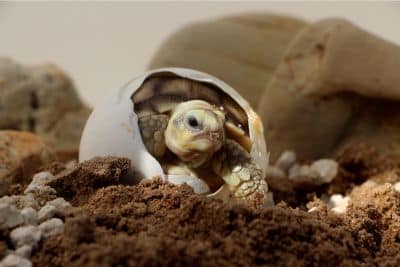The Sulcata tortoise (Centrochelys sulcata) is also known as the African spurred tortoise. This is due to the ‘spurs’ or ‘spikes present on their hind legs.
It is native to Africa and is the third-largest species of tortoise in the world. It’s easy to distinguish between males and females of some animals, regardless of whether they are adults or juveniles. However, when it comes to sexing Sulcata tortoises, it takes more than just a quick glance at their physical appearance.
Whether you have just purchased one as a pet, or your current female has laid some eggs, it is important to understand how to sex a sulcata tortoise. Although this can be a little tricky to the untrained eye, I have compiled this article to provide you with all the information you need to be able to accurately sex your tortoise, from physical to behavioral indicators.
Why Sexing Your Sulcata Tortoise is Important
Sulcata tortoises are currently listed as vulnerable by the IUCN. Therefore, breeding programs are imperative in order to grow population numbers.
An important part of these much needed breeding programs involves knowing the sex of tortoises to facilitate controlled reproduction. It means that breeders can pair compatible individuals to produce offspring with desirable traits or contribute to conservation efforts. It also helps to ensure genetic diversity and healthy populations within captive breeding programs.
Additionally, being able to sex tortoises allows breeders to monitor and manage the breeding process effectively, leading to successful reproduction and the continuation of the species. Interestingly, a single male is enough to mate with at least 4 females.
Understanding the health care needs of male and female tortoises is essential for ensuring their well-being. Like all animals, care requirements differ based on sex. For example, female tortoises need specific care during egg-laying periods, such as providing a suitable nesting area and monitoring their calcium levels to prevent issues such as egg binding.
On the other hand, male tortoises will exhibit particular behaviors during the mating season that often require specific attention. By tailoring your Sulcata’s care based on their sex-specific needs, you’ll be better equipped to maintain the health and happiness of your Sulcata tortoise in the long term.
Sulcata tortoises are generally solitary and typically only come together in the wild for breeding purposes. Females tend to be less aggressive than males and are more likely to be seen together in the wild, such as coming together to forage in areas with a high density of food. However, they are unlikely to exhibit any social behaviors with one another.
Male tortoises in particular can be territorial and aggressive, so should not be kept together.
Differentiating Between Male and Female Sulcatas
Like other reptiles, determining the sex of a Sulcata depends somewhat on egg incubation temperature and weather. Eggs incubated under warmer temperatures are more likely to be female, whilst those incubated under cooler temperatures are more likely to be male.
Sulcata tortoises can generally be sexed reliably when their shell length reaches 10 to 12 inches, this is typically at the age of around 5 years old. Bear in mind however, that growth rates can vary based on diet, environment, and overall health, so some tortoises might be sexed accurately a bit earlier or later than others.
At around this stage in maturity, certain features, known as secondary sexual characteristics, become easier to distinguish, as follows:
- Males have longer, wider tails with a spur on the end. Females, however, have less conspicuous tails. They are shorter and blunt and the cloacal opening is near the base.
- The gular scutes (the part of the shell that projects under the neck) are more pronounced and longer in males than in females.
- Males usually have a concave plastron (the underside of the shell), which helps them mount females during mating. Females have a flatter plastron.
- Males have broad anal scutes (located on the plastron at the rear end of the tortoise) that form a wide ‘V’ shape. Conversely, female anal scutes are more circular in outline and form a ‘U’ shape. This creates a larger opening that aids the laying of eggs.
In terms of sexing newly hatched Sulcatas, you will need to take it to a veterinarian who will perform an endoscopy.

Other Physical Characteristics
Aside from these secondary sexual characteristics that develop with maturity, male and female Sulcata tortoises are mostly identical on the outside.
As is typical with many other tortoise species, males tend to be larger than females. Male Sulcatas weigh at least 120 pounds on average, whereas females are typically between 65 and 75 pounds.
Additionally, males average a length of 24 inches, and females are around 16 inches in length. Moreover, males tend to have more vivid coloration.
As is the case with Sulcatas, shell shape is a great way to determine the sex of many other tortoise species too. Tortoise shells are made of two halves, which are sandwiched together to hold the tortoise’s body inside. The top part of the shell is called the ‘carapace’ whilst the underneath of the shell is called the ‘plastron’.
Typically, males have an indented or concave plastron, which allows them to fit over the convex shell of a female during mating. Females have flatter or even slightly convex plastrons, which provides more internal room for growing eggs.
Behavioral Indicators
Like all tortoise species, male Sulcatas become very aggressive during mating season. Such behaviors can be used to easily distinguish the sexes. Due to heightened aggression, males will often fight other males over females, attempting to flip one another over.
Males will court females by bobbing his head at her, nipping and biting at her legs and the edges of her shell and even ramming into her. Females receiving this courtship behavior will pull her head and limbs into her shell, allowing the male to mount.
The act of intercourse is often very loud, with males vocalizing.
A ‘gravid’or egg-bearing female will exhibit nesting behaviors, which is another way you can identify the sex of your tortoises. Once a suitable nesting site has been chosen, females will use their hind legs to begin to dig a nest.
After 60-90 days, the female will lay her eggs in the nest. You can observe her extending her head and neck fully and then pulling it back into the shell with the effort of pushing the eggs out.
Female tortoises can lay 15 to 30 eggs per clutch between 2 and 5 times a year.
After the eggs have been laid, she will cover them over with soil. Like many tortoise species, female Sulcatas provide no maternal care.
Age and Maturity
Sulcata tortoises can live 100 years or longer in captivity. By the age of around 25, your tortoise should be full grown as far as size and weight are concerned.
Every species of tortoise will reach sexual maturity at different ages, though males tend to mature slightly faster than females. For Sulcata tortoises, sexual maturity is typically reached at around 5 years of age, when shell length reaches 10 to 12 inches, and they are around 11 to 18 kg in weight.
Signs of sexual maturity are often the same signs that allow you to determine the sex. For example, physical signs include males developing longer tails and a concave plastron. Behavioral signs include females digging nests in preparation for egg laying.
If your tortoise is under 4 years old, it is very difficult to determine the sex. This would require an endoscopy from a veterinarian.
Citations
- British Chelonia Group – temperature
- Firenze University Press – morphological differences
- iNaturalist – Centrochelys sulcata
- Oxford Academic – mating behaviors
Twycross Zoo – IUCN status


